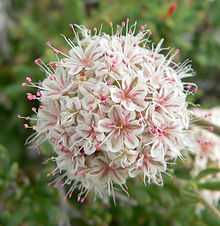Eriogonum fasciculatum
| Eriogonum fasciculatum | |
|---|---|
 | |
| Scientific classification | |
| Kingdom: | Plantae |
| (unranked): | Angiosperms |
| (unranked): | Eudicots |
| (unranked): | Core eudicots |
| Order: | Caryophyllales |
| Family: | Polygonaceae |
| Genus: | Eriogonum |
| Species: | E. fasciculatum |
| Binomial name | |
| Eriogonum fasciculatum Benth. | |
Eriogonum fasciculatum is a species of wild buckwheat known by the common names California buckwheat and Eastern Mojave buckwheat. This common shrub is native to the southwestern United States and northwestern Mexico, where it grows on scrubby slopes and in chaparral and dry washes in a number of habitats.
There are a number of distinct varieties. It is variable in appearance, forming a patchy, compact bramble or a spreading bush approaching two meters in height and three across. The leaves grow in clusters at nodes along the branches and are leathery, woolly on the undersides, and rolled under along the edges. Flowers appear in dense, frilly clusters which may be anywhere from a few millimeters to 15 centimeters wide. Each individual flower is pink and white and only a few millimeters across.[1]
Uses
Many Native American groups utilized parts of this plant for a number of medicinal uses, including the treatment of headache, diarrhea, and wounds. The Zuni people use a poultice of powdered root and apply it cuts and arrow or bullet wounds. A decoction of root taken after parturition to heal lacerations. This same decoction is also taken for hoarseness and colds involving the throat.[2]
This species is particularly attractive to honey bees (Apis mellifera) and is a good source of nectar over many months in dryer areas.
Notes
- ↑ "E. fasciculatum (Benth.) Torr. & A. Gray". Jepson Manual. University of California. 1993. Retrieved 2009-04-12.
- ↑ Stevenson, Matilda Coxe 1915 Ethnobotany of the Zuni Indians. SI-BAE Annual Report #30 (p. 49)
External links
- Jepson Manual Treatment
- USDA Plants Profile
- Flora of North America Profile
- Ethnobotany
- Photo gallery